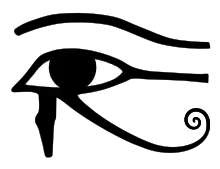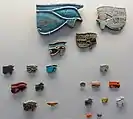Eye of Horus
The Eye of Horus, also known as wadjet, wedjat[1][2][3] or udjat,[4][5] is an ancient Egyptian symbol of protection, royal power, and good health. The Eye of Horus is similar to the Eye of Ra, which belongs to a different god, Ra, but represents many of the same concepts.[6]

_Eye_of_Horus_pendant.jpg.webp)
Funerary amulets were often made in the shape of the Eye of Horus.[3] The symbol "was intended to protect the pharaoh [here] in the afterlife"[3] and to ward off evil. Ancient Egyptian and Middle-Eastern sailors would frequently paint the symbol on the bows of their vessels to ensure safe sea travel.[7]
Horus
Horus was the ancient Egyptian sky god who was usually depicted as a falcon, most likely a lanner or peregrine falcon.[8] His right eye was associated with the sun god, Ra. The eye symbol represents the marking around the eye of the falcon, including the "teardrop" marking sometimes found below the eye. The mirror image, or left eye, sometimes represented the moon and the god Djehuti (Thoth).[9]
| wedjet – Eye of Horus in hieroglyphs |
|---|
It was believed by the Greeks and Romans that an evil heart could get to the eye. The thought to be powerful effects of eyes and optics created the myth that the energy-producing power of the eye had the ability to cast evil spells with just a glance. Because the ancients believed the evil eye could be counteracted with a 'good eye', myths about Horus arose.[10]
In one myth, when Set and Horus were fighting for the throne after Osiris's death, Set gouged out Horus's left eye. The majority of the eye was restored by either Hathor or Thoth. When Horus's eye was recovered, he offered it to his father, Osiris, in hopes of restoring his life. Hence, the eye of Horus was often used to symbolise sacrifice, healing, restoration, and protection.[11]
As hieroglyph and symbol
There are seven different hieroglyphs used to represent the eye, most commonly "ir.t" in Egyptian, which also has the meaning "to make or do" or "one who does".[5] In Egyptian myth the eye was not the passive organ of sight but more an agent of action, protection or wrath. The Eye of Horus was represented as a hieroglyph, designated D10 in Gardiner's sign list.[12] It is represented in the Unicode character block for Egyptian hieroglyphs as U+13080 (𓂀).[13]
Gallery
 Wooden case decorated with bronze, silver, ivory and gold
Wooden case decorated with bronze, silver, ivory and gold
 Collection of amulets in the British Museum Room 62
Collection of amulets in the British Museum Room 62 Earthenware Wedjat amulet on display at the Louvre, c. 500–300 BCE
Earthenware Wedjat amulet on display at the Louvre, c. 500–300 BCE Scarab. The Walters Art Museum
Scarab. The Walters Art Museum Painting of Horus in the Temple of Hatshepsut
Painting of Horus in the Temple of Hatshepsut Detail. False door of Senenmut. Two mirror-image Eyes of Horus appear. Neues Museum
Detail. False door of Senenmut. Two mirror-image Eyes of Horus appear. Neues Museum
References
- Pommerening, Tanja (2005). Die altägyptischen Hohlmaße. Studien zur Altägyptischen Kultur. Beiheft 10. Hamburg: Helmut Buske Verlag.
- Stokstad, Marilyn (2007). "Chapter 3: Art of Ancient Egypt". Art History. Volume 1 (3rd ed.). Upper Saddle River, N.J.: Pearson Prentice Hall. ISBN 9780131743205. OCLC 238783244.
- Silverman, David P. (1997). "Chapter 14: Egyptian Art". Ancient Egypt. Duncan Baird Publishers. p. 228.
- Bongioanni, Alessandro; Croce, Maria, eds. (2003). The Treasures of Ancient Egypt: From the Egyptian Museum in Cairo. Universe Publishing. p. 622. According to the editors, "Udjat" was the term for amulets which used the Eye of Horus design.
- Butler, Edward P. "Wadjet". Goddesses and Gods of the Ancient Egyptians: A Theological Encyclopedia. Henadology: Philosophy and Theology. Retrieved October 4, 2010.
- Darnell, John Coleman (1997). "The Apotropaic Goddess in the Eye". Studien zur Altägyptischen Kultur, 24. pp. 35–37.
- Freeman, Charles (1997). The Legacy of Ancient Egypt. Facts on File. p. 91.
- Wilkinson, Richard H. (2003). The Complete Gods and Goddesses of Ancient Egypt. Thames & Hudson. p. 202.
- "Eye of Horus, Eye of Ra (Udjat, Wedjet)". Symboldictionary.net. Archived from the original on 2012-02-23. Retrieved 2012-01-17.
- Bohigian, G. (1997). The history of the evil eye and its influence on ophthalmology, medicine and social customs. Documenta Ophthalmologica, 94(1), 91-100.
- Pinch, Geraldine (2004). Egyptian Mythology: A Guide to the Gods, Goddesses, and Traditions of Ancient Egypt. Oxford University Press. pp. 131–132
- Allen, James P. (2000). Middle Egyptian: An Introduction to the Language and Culture of Hieroglyphs. Cambridge University Press. p. 426
- Unicode standard for Egyptian hieroglyphs
External links
| Wikimedia Commons has media related to Eye of Horus. |
